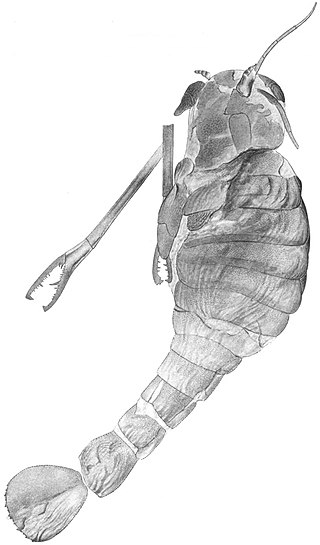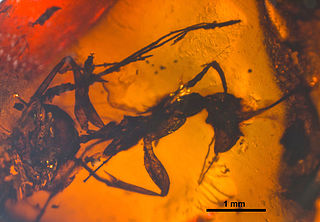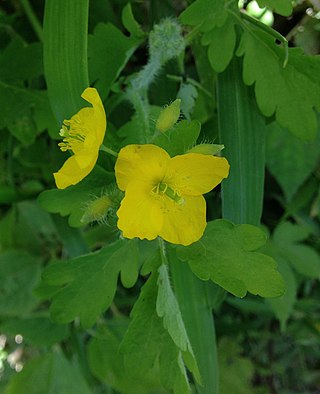
Acutiramus is a genus of giant predatory eurypterid, an extinct group of aquatic arthropods. Fossils of Acutiramus have been discovered in deposits of Late Silurian to Early Devonian age. Seven species have been described, five from North America and two from the Czech Republic. The generic name derives from Latin acuto and Latin ramus ("branch"), referring to the acute angle of the final tooth of the claws relative to the rest of the claw.

Parribacus japonicus, the Japanese mitten lobster, is a species of slipper lobster. Though the common name for this lobster is the Japanese mitten lobster, it is locally called zōri-ebi (ゾウリエビ) – zōri denoting the Japanese sandal it resembles, and ebi meaning shrimp or lobster.

Brownimecia is an extinct genus of ants, the only genus in the tribe Brownimeciini and subfamily Brownimeciinae of the Formicidae. Fossils of the single identified species, Brownimecia clavata, are known from the Middle Cretaceous of North America. The genus is one of several ants described from Middle Cretaceous ambers of New Jersey. Brownimecia was initially placed in the subfamily Ponerinae, until it was transferred to its own subfamily in 2003; it can be distinguished from other ants due to its unusual sickle-like mandibles and other morphological features that makes this ant unique among the Formicidae. The ant is also small, measuring 3.43 millimetres (0.135 in), and a stinger is present in almost all of the specimens collected. The morphology of the mandibles suggest a high level of feeding specialization.

Promyopias is an Afrotropical genus of ant in the subfamily Ponerinae containing the single species Promyopias silvestrii. The rare genus has previously been regarded as a separate genus, as a subgenus and as a provisional synonymy, but was reinstated at genus-rank in 2008.

Zigrasimecia is an extinct genus of ants which existed in the Cretaceous period approximately 98 million years ago. The first specimens were collected from Burmese amber in Kachin State, 100 kilometres (62 mi) west of Myitkyina town in Myanmar. In 2013, palaeoentomologists Phillip Barden and David Grimaldi published a paper describing and naming Zigrasimecia tonsora. They described a dealate female with unusual features, notably the highly specialized mandibles. Other features include large ocelli, short scapes, 12 antennomeres, small eyes, and a clypeal margin that has a row of peg-like denticles. The genus Zigrasimecia was originally incertae sedis within Formicidae until a second species, Zigrasimecia ferox, was described in 2014, leading to its placement in the subfamily Sphecomyrminae. Later, it was considered to belong to the distinct subfamily Zigrasimeciinae.

Archimyrmex is an extinct genus of ant in the formicid subfamily Myrmeciinae, described by palaeoentomologist Theodore Cockerell in 1923. The genus contains four described species, Archimyrmex rostratus, Archimyrmex piatnitzkyi, Archimyrmex smekali and Archimyrmex wedmannae. Archimyrmex is known from a group of Middle Eocene fossils which were found in North America, South America, and Europe. The genus was initially placed in the subfamily Ponerinae, but it was later placed in Myrmeciinae; it is now believed to be the ancestor of the extant primitive genus Myrmecia from Australia. Despite this, Archimyrmex is not a member to any tribe and is regarded as incertae sedis within Myrmeciinae. However, some authors believe Archimyrmex should be assigned as incertae sedis within Formicidae. These ants can be characterised by their large mandibles and body length, ranging from 13.2 to 30 mm. They also have long, thin legs and an elongated mesosoma (thorax) and petiole.

Yantaromyrmex is an extinct genus of ants first described in 2013. Members of this genus are in the subfamily Dolichoderinae of the family Formicidae, known from Middle Eocene to Early Oligocene fossils found in Europe. The genus currently contains five described species, Y. constrictus, Y. geinitzi, Y. intermedius, Y. mayrianum and Y. samlandicus. The first specimens were collected in 1868 and studied by Austrian entomologist Gustav Mayr, who originally placed the fossils in other ant genera until the fossils were reviewed and subsequently placed into their own genus. These ants are small, measuring from 4 to 6 mm in length and can be characterized by their trapezoidal shaped head-capsules and oval compound eyes that are located slightly to the rear of the capsules midpoint, with no known ocelli present.

Zherichinius is an extinct genus of ants in the subfamily Dolichoderinae known from fossils found in amber from the Middle Eocene of Sakhalin island Far eastern Russia and Bitterfeld, Germany. At the time of description the species Zherichinius horribilis and Zherichinius rapax were two of eight ant species known from Sakhalin fossils.

Pseudectatomma is an extinct genus of ants in the formicid subfamily Ectatomminae described by from fossils found in Europe. The genus contains two species dating from the Eocene, Pseudectatomma eocenica and Pseudectatomma striatula.

Protopone is an extinct genus of ants in the formicid subfamily Ponerinae described from fossils found in Europe and Asia. There are seven described species placed into the genus, Protopone? dubia, Protopone germanica, Protopone magna, Protopone oculata, Protopone primigena, Protopone sepulta, and Protopone vetula. Protopone is one several Lutetian Ponerinae genera.

Cyrtopone is an extinct genus of ants in the formicid subfamily Ponerinae described from fossils found in Europe. There are four described species placed into the genus, Cyrtopone curiosa, Cyrtopone elongata, Cyrtopone microcephala, and Cyrtopone striata. Cyrtopone is one several Lutetian Ponerinae genera.

Messelepone is an extinct genus of ants in the formicid subfamily Ponerinae described from fossils found in Europe. M. leptogenoides is the only species assigned to the genus, which is one of several Lutetian Ponerinae genera.

Gerontoformica is an extinct genus of stem-group ants. The genus contains thirteen described species known from Late Cretaceous fossils found in Asia and Europe. The species were described between 2004 and 2016, with a number of the species formerly being placed into the junior synonym genus Sphecomyrmodes.

Camelomecia is an extinct genus of stem-group ants not placed into any Formicidae subfamily. Fossils of the single known species, Camelomecia janovitzi, are known from the Middle Cretaceous of Asia. The genus is one of several ants described from Middle Cretaceous ambers of Myanmar.

Bradoponera is an extinct genus of ant in the Formicidae subfamily Proceratiinae, and is one of four genera of the subfamily. The genus contains four described species Bradoponera electrina, Bradoponera meieri, Bradoponera similis, and Bradoponera wunderlichi. The species are known from several Middle Eocene amber fossils which were found in Europe.

Karusasaurus, commonly known as Karusa lizards, is a genus of lizards in the family Cordylidae.

Chelidonium, commonly known as celandines, is a small genus of flowering plants in the poppy family, This genus is native to northern Africa and Eurasia, where they are widespread, ranging from western Europe to east Asia.

Polyzonus is a genus of long-horned beetles. About 35 species have been described in this genus and they are distributed in the Indomalayan Realm.
Sphegina collicola is a species of hoverfly found in Malaysia.


















